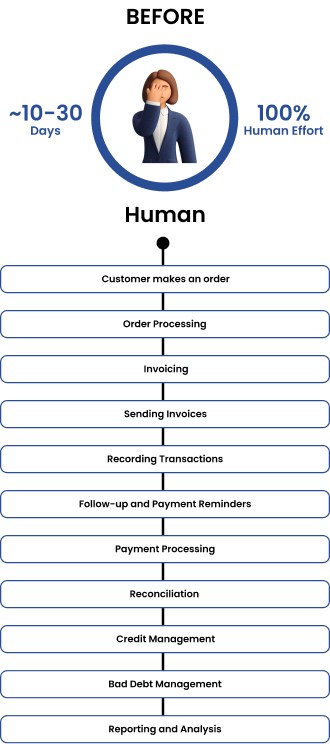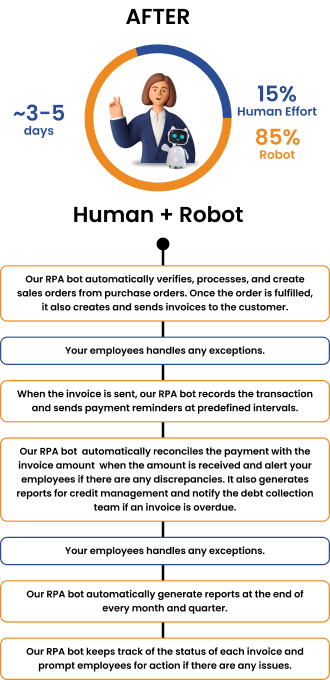Talosnation
Accounts receivable in the manufacturing industry is an area where you handle a lot of invoices, payment collection, matching payments with invoices, and posting them to your ERP system. This often involves a lot of manual data entry and extraction.
So far, we've used various applications to digitize the process, with an employee acting as the go-between to transfer data and create final outputs. However, humans are prone to errors when repeating the same tasks, even though they're great at making decisions. It's time to rethink and redesign our workflow, using AI and RPA to let humans focus on what they do best and let the bots handle the repetitive tasks.
Before we improve the process, we need to understand how it currently works and identify where the problems are and how to fix them.
Let’s take a look at the accounts receivable workflow from an employee's perspective:
So, here's the accounts receivable process in the daily lives of Sarah, an Accounts Receivable Specialist at XYZ Manufacturing Enterprises, and Mike, the CFO of their customer company, ABC Enterprises.

1. Customer makes an order
Mike needs specialized circuit boards, so he sends a purchase order to Sarah at XYZ Manufacturing. The order includes details like the company name, date, quantity, description, price, delivery date, and payment terms.
2. Order Processing
Sarah receives Mike's order and reviews it to make sure everything matches the agreed terms. She then creates a sales order with details about the goods, quantity, price, and delivery information.
3. Invoicing
After XYZ Manufacturing ships the circuit boards to ABC Enterprises, Sarah generates an invoice. It includes the quantity, prices, and payment terms, specifying when Mike needs to pay, which could be in 30, 60, or 90 days. The invoice also mentions any late payment fees.
4. Sending Invoices
Sarah emails the invoice to Mike at ABC Enterprises and confirms it was sent. Mike’s team receives it and adds it to their payment queue.
5. Recording Transactions
Sarah updates XYZ Manufacturing's accounting system to log the sale and add the amount to ABC Enterprises’s accounts receivable balance.
6. Follow-up and Payment Reminders
As the payment due date nears, Sarah sends a friendly reminder email to Mike. If needed, she sends follow-ups at 7, 14, 30, and 45 days past the due date, and so on until 90 days.
7. Payment Processing
After getting Sarah's reminder, Mike tells his team to process the payment. ABC Enterprises’s accounts payable team sends the payment via bank transfer, and it shows up in XYZ Manufacturing's account.
8. Reconciliation
Sarah checks that the payment from ABC Enterprises matches the invoice amount in the accounting system, confirming successful payment.
9. Credit Management
Sarah regularly reviews ABC Enterprises's credit limit and payment history to make sure they're still good to work with, adjusting credit terms if needed to keep the business relationship strong.
10. Bad Debt Management
If invoices aren’t paid despite reminders, Sarah works with XYZ Manufacturing's collections team to take further action or start debt recovery procedures.
11. Reporting and Analysis
Sarah creates reports on accounts receivable metrics like Days Sales Outstanding (DSO) and aging of receivables. This helps XYZ Manufacturing's management understand cash flow and make smart decisions.
Now that we understand the entire process, let’s identify its current problems and see how RPA can make it more efficient.

1. Customer makes an order
Problem: Orders might have incomplete or incorrect details, leading to processing delays. At scale, it can take a long time for employees to check each purchase order, identify errors, and follow up with customers.
RPA Solution: Our RPA bots can automate the verification of purchase order details, ensuring all required fields are complete and accurate before processing. They can also cross-check information against your existing data for consistency.
2. Order Processing
Problem: When your employee has to manually review the purchase order and create a sales order, it takes a lot of time and is prone to errors.
RPA Solution: Our RPA bots can automatically extract details from the purchase order and populate the sales order. This reduces your employee’s manual effort and errors, speeding up the process.
3. Invoicing
Problem: Generating and ensuring the accuracy of invoices can be tedious and prone to mistakes when done manually by your employees.
RPA Solution: Our RPA bots can automate the generation of invoices based on your defined template and data extracted from the sales order. They ensure all necessary details are included, reducing errors.
4. Sending Invoices
Problem: Manually sending invoices at scale could lead to disasters where invoices might not be sent on time.
RPA Solution: Our RPA bots can automate the emailing of invoices to your customers, ensuring they are sent promptly and to the correct recipient. They can also log the dispatch for tracking purposes.
5. Recording Transactions
Problem: Manually updating the accounting system can be slow and prone to data entry errors.
RPA Solution: Our RPA bots can automatically update your accounting system with sales and invoice data, ensuring accurate and timely record-keeping.
6. Follow-up and Payment Reminders
Problem: Manually tracking the due dates of thousands of invoices and sending reminders can be inconsistent and inefficient.
RPA Solution: Our RPA bots can monitor payment due dates and automatically send reminder emails at predefined intervals (e.g., 7, 14, 30, and 45 days past due). This ensures timely follow-up without manual intervention.
7. Payment Processing
Problem: Payment processing can be delayed if reminders are not acted upon promptly. Following up on each invoice at scale manually is impossible for a human.
RPA Solution: Our RPA bots can monitor incoming payments, match them to corresponding invoices, and update your accounting system. They can also notify your accounts receivable team if payments are not received within a specified time frame.
8. Reconciliation
Problem: Manual reconciliation can be time-consuming and prone to discrepancies.
RPA Solution: Our RPA bots can automatically reconcile payments with invoices in the accounting system, highlighting any discrepancies for further investigation by your accounts receivable team.
9. Credit Management
Problem: Regularly reviewing credit limits and payment histories manually can be inefficient.
RPA Solution: Our RPA bots can periodically analyze customer payment histories and credit limits, generating reports and alerts for any anomalies or required adjustments, aiding in proactive credit management.
10. Bad Debt Management
Problem: Identifying and managing overdue invoices manually can be inconsistent. Automatically tagging and forwarding the bad invoices to the debt collection team immediately saves a lot of time and effort for everyone.
RPA Solution: Our RPA bots can monitor overdue invoices and trigger workflows for collection efforts, such as automated reminders, escalation to the collections team, or initiating debt recovery procedures.
11. Reporting and Analysis
Problem: Generating reports manually can be a time-consuming and error-prone task for your employees.
RPA Solution: Our RPA bots can automate the generation of accounts receivable reports, providing real-time insights into metrics like Days Sales Outstanding (DSO) and aging of receivables. This ensures accurate and timely data for decision-making.
So, there you have it – RPA to your rescue! By harnessing the power of automation, we can streamline your Patient Onboarding process, slash processing times, and free up your valuable time and resources for more strategic tasks.
While these areas give us a good idea of how RPA can boost efficiency and productivity, there might be even more opportunities when we zoom in and look at the finer details. Since all company's processes are unique, we can't give specific advice until we take a closer look at each one. If you're curious to learn more, then you can reach out to the experts at TalosNation, who specialize in RPA, and we can help you streamline your Account receivable processes or drop us a message on LinkedIn. We're always here to help out!
